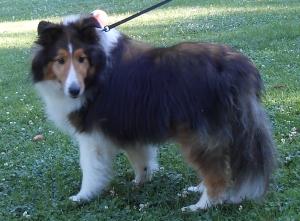Shetland Sheepdog (Sheltie)
Category: Herding Dogs

Facts about the Shetland Sheepdog, it is a herding dog breed and is often recognized as the Sheltie, which is native to Scotland. Shetland Sheepdogs are vocal, highly strung, active dogs that are eager to satisfy and work hard at all times. Shetland Sheepdogs are partially based on dogs exploited in the Shetland Isles for directing and defending sheep. This dog breed is most likely a successor of small samplings of the King Charles Spaniel and the Scottish Collie. The Shetland Sheepdog was developed to lean the very small sheep of the Shetland Islands, whose harsh, tempestuous shores have shaped other petite-sized animals, like the Shetland pony. Nowadays, the Shetland Sheepdog is raised as a family pet and farm dog. This dog breed was officially recognized in 1909 by the Kennel Club.
Features
The Shetland Sheepdog is a small to average-sized dog, such that male dogs are taller than the female ones, with the body height that ranges from 13 inches to 16 in (33 cm to 41 cm), whereas the female dogs have a body height between 13 inches and 16 inches (33 cm and 41 cm). Male dogs are also heavier than the female dogs with the body mass that ranges from 11 lbs and 24 lbs (5.0 kg and 10.9 kg), whereas the female dogs have a body weight between 11 lbs and 24 lbs (5.0 kg and 10.9 kg).
The general look of the Shetland Sheepdog is that of an elongated coated breed of dog, the Rough Collie. The Shetland Sheepdog is a small, double layered, functioning dog, and it is agile and strong. The elongated, rough protective hairs lie over a thick, flexible undercoat. The protective hairs are water-repulsive, whereas the undercoat offers the dog the required relief from both low and high temperatures.
These Shetland Sheepdog comes in a range of colors, such as tri-color, sable, and blue merle.
The tri-color Shetland Sheepdog variety includes three colors, such as white, black, and tan in its body. Tricolor is leading over the bi-black. They may be carrying two tri genes, or possibly bi-factored, holding one bicolor gene and one tricolor gene.
In the Sable-colored Shetland Sheepdogs, the Sable overrides other colors. May be totally sable, holding 2 sable genes, or maybe, bi-factored or tri-factored, holding one sable gene and one bicolor or tricolor gene.
Blue merle Shetland Sheepdogs of this breed may boast blue color eyes or one blue or one brown color eye, but all other dog varieties will boast dark colored eyes.
Temperament
The expression of the Shetland Sheepdog would be that of attentiveness with a mild and occasionally reserved nature. They are habitually very good with kids. These Shetland Sheepdogs would hold their tails down low, and they would only raise their tails while alert and would never carry over the back. They are a deeply faithful breed, occasionally reserved with unknown people, but they would not be shy or demonstrate timidness.
Behavior
As the name indicates a Shetland Sheepdog can and have been employed as a sheepdog and still partake in sheepdog tests to this day. Herding dogs can guide farm animals to move from one place to another place by causing flight behavior and fear-flocking. The nature to herd is chiefly a product of breeding. The female dog is capable of giving birth to 4 to 6 puppies in a breeding season. Variation in dimensions can be seen within litters that range from 16 inches to 20 inches (40 cm to 50 cm).
The Shetland Sheepdog dominates nimbleness, respect, showmanship, tracking, Flyball, and herding in their size cluster. Herding characters and training can be considered at noncompetitive herding checks. The dogs that demonstrating basic herding characters can be trained to vie in herding tests.
The average lifespan of the Shetland Sheepdog ranges from 12 years to 13 years.

 Back To Category Herding Dogs
Back To Category Herding Dogs